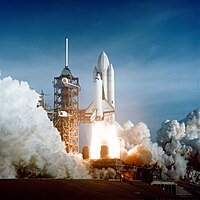
Photo from wikipedia
Purpose The main purpose of this work was elaboration and verification of a method of assessing the sensitivity of automatic control laws to parametric uncertainty of an airplane’s mathematical model.… Click to show full abstract
Purpose The main purpose of this work was elaboration and verification of a method of assessing the sensitivity of automatic control laws to parametric uncertainty of an airplane’s mathematical model. The linear quadratic regulator (LQR) methodology was used as an example design procedure for the automatic control of an emergency manoeuvre. Such a manoeuvre is assumed to be pre-designed for the selected airplane. Design/methodology/approach The presented method of investigating the control systems’ sensitivity comprises two main phases. The first one consists in computation of the largest variations of gain factors, defined as differences between their nominal values (defined for the assumed model) and the values obtained for the assumed range of parametric uncertainty. The second phase focuses on investigating the impact of the variations of these factors on the behaviour of automatic control in the manoeuvre considered. Findings The results obtained allow for a robustness assessment of automatic control based on an LQR design. Similar procedures can be used to assess in automatic control arrived at through varying design methods (including methods other than LQR) used to control various manoeuvres in a wide range of flight conditions. Practical implications It is expected that the presented methodology will contribute to improvement of automatic flight control quality. Moreover, such methods should reduce the costs of the mathematical nonlinear model of an airplane through determining the necessary accuracy of the model identification process, needed for assuring the assumed control quality. Originality/value The presented method allows for the investigation of the impact of the parametric uncertainty of the airplane’s model on the variations of the gain-factors of an automatic flight control system. This also allows for the observation of the effects of such variations on the course of the selected manoeuvre or phase of flight. This might be a useful tool for the design of crucial elements of an automatic flight control system.
Journal Title: Aircraft Engineering and Aerospace Technology
Year Published: 2019
Link to full text (if available)
Share on Social Media: Sign Up to like & get
recommendations!